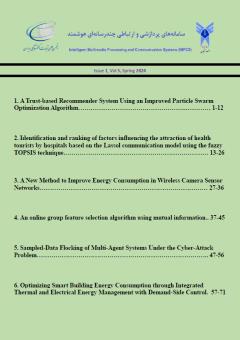-
-
List of Articles
-
Open Access Article
1 - A Trust-based Recommender System Using an Improved Particle Swarm Optimization Algorithm
Sajad Ahmadian Mohammad Hossein Olyaee -
Open Access Article
2 - Identification and ranking of factors influencing the attraction of health tourists by hospitals based on the Lassol communication model using the fuzzy TOPSIS technique.
maryam amiri ali mohamad sharifi mazid abadi shahnaz hashemi -
Open Access Article
3 - A New Method to Improve Energy Consumption in Wireless Camera Sensor Networks
javad bayat Shiva Karimi -
Open Access Article
4 - An Online group feature selection algorithm using mutual information
maryam rahmaninia sondos bahadori -
Open Access Article
5 - Sampled-Data Flocking of Multi-Agent Systems Under the Cyber-Attack Problem
سحر یزدانی -
Open Access Article
6 - Optimizing Smart Building Energy Consumption through Integrated Thermal and Electrical Energy Management with Demand-Side Control
Alireza Moradi Seyyed Mohammad R. Hashemi maryam faridpour
-
The rights to this website are owned by the Raimag Press Management System.
Copyright © 2021-2025







